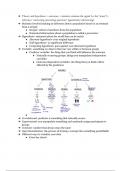Carolynskotz
On this page, you find all documents, package deals, and flashcards offered by seller carolynskotz.
- 16
- 0
- 0
Community
- Followers
- Following
16 items

PSYC 200 exam 2 study guide
This study guide focuses on statistical concepts related to hypothesis testing and analysis of variance (ANOVA). It discusses the importance of understanding different types of errors, such as Type I and Type II errors, and the trade-off between them. The guide also addresses the issue of "p-hacking," where the choice of statistical analyses is based on achieving significant results rather than following a pre-determined plan. It then introduces linear regression as a tool for making predictio...
- Class notes
- • 10 pages •
This study guide focuses on statistical concepts related to hypothesis testing and analysis of variance (ANOVA). It discusses the importance of understanding different types of errors, such as Type I and Type II errors, and the trade-off between them. The guide also addresses the issue of "p-hacking," where the choice of statistical analyses is based on achieving significant results rather than following a pre-determined plan. It then introduces linear regression as a tool for making predictio...

PSYC 200 exam 1 study guide
This study guide provides an introduction to statistical concepts and their application in hypothesis testing and data analysis. It covers key terms such as variables, hypothesis testing, and different types of visualizations for data presentation. The guide explains how to calculate and interpret various measures of central tendency, dispersion, and transformation. It also introduces the concept of sampling distributions and confidence intervals, emphasizing the distinction between descriptive ...
- Class notes
- • 9 pages •
This study guide provides an introduction to statistical concepts and their application in hypothesis testing and data analysis. It covers key terms such as variables, hypothesis testing, and different types of visualizations for data presentation. The guide explains how to calculate and interpret various measures of central tendency, dispersion, and transformation. It also introduces the concept of sampling distributions and confidence intervals, emphasizing the distinction between descriptive ...

PSYC 160 Final study guide
This study guide covers various topics related to the human brain and nervous system, including the blood supply to the brain, cell signaling, action potentials, and the somatosensory, motor, and sensory systems. It also discusses the role of the thalamus, cerebellum, and basal ganglia in movement control and learning. The guide provides an overview of the somatic senses, interoception, pain, and chemical senses, as well as the auditory and visual systems. Additionally, it touches on the challen...
- Class notes
- • 75 pages •
This study guide covers various topics related to the human brain and nervous system, including the blood supply to the brain, cell signaling, action potentials, and the somatosensory, motor, and sensory systems. It also discusses the role of the thalamus, cerebellum, and basal ganglia in movement control and learning. The guide provides an overview of the somatic senses, interoception, pain, and chemical senses, as well as the auditory and visual systems. Additionally, it touches on the challen...

PSYC 160 anatomy + people
This study guide covers the anatomy of the nervous system, including the central and peripheral divisions, and their structural components. It then discusses several case studies of individuals with memory impairments, providing insights into different memory systems and their functioning. The cases range from anterograde and retrograde amnesia to dissociations between short-term and long-term memory, semantic and episodic memory, and perceptual priming and explicit memory. The guide highlights ...
- Class notes
- • 7 pages •
This study guide covers the anatomy of the nervous system, including the central and peripheral divisions, and their structural components. It then discusses several case studies of individuals with memory impairments, providing insights into different memory systems and their functioning. The cases range from anterograde and retrograde amnesia to dissociations between short-term and long-term memory, semantic and episodic memory, and perceptual priming and explicit memory. The guide highlights ...

EEB 228 exam 2 study guide
This study guide covers the evolution of pathogens and the role of adaptive immunity, vaccine-induced evolution, and disease emergence. It discusses adaptive immunity characteristics, including immunological memory and the "old friends hypothesis." Non-vaccine methods to combat disease spread, such as culling and breeding for resistance, are explored. Vaccination and pathogen evolution are addressed, highlighting the potential for "escape mutants" in vaccinated populations. The guide introdu...
- Class notes
- • 14 pages •
This study guide covers the evolution of pathogens and the role of adaptive immunity, vaccine-induced evolution, and disease emergence. It discusses adaptive immunity characteristics, including immunological memory and the "old friends hypothesis." Non-vaccine methods to combat disease spread, such as culling and breeding for resistance, are explored. Vaccination and pathogen evolution are addressed, highlighting the potential for "escape mutants" in vaccinated populations. The guide introdu...

EEB 228 exam 1 study guide
This study guide for EEB 228 Exam 1 covers a range of topics, including environmental conditions, resources, evolution, parasites, pathogens, infectious diseases, disease dynamics, and host behavior. It begins by discussing the resources necessary for sustaining life and the challenges posed by limited resources, such as human population growth. The guide then explains evolution via natural selection, highlighting variations among individuals and how populations reflect successful variants. Para...
- Class notes
- • 20 pages •
This study guide for EEB 228 Exam 1 covers a range of topics, including environmental conditions, resources, evolution, parasites, pathogens, infectious diseases, disease dynamics, and host behavior. It begins by discussing the resources necessary for sustaining life and the challenges posed by limited resources, such as human population growth. The guide then explains evolution via natural selection, highlighting variations among individuals and how populations reflect successful variants. Para...
